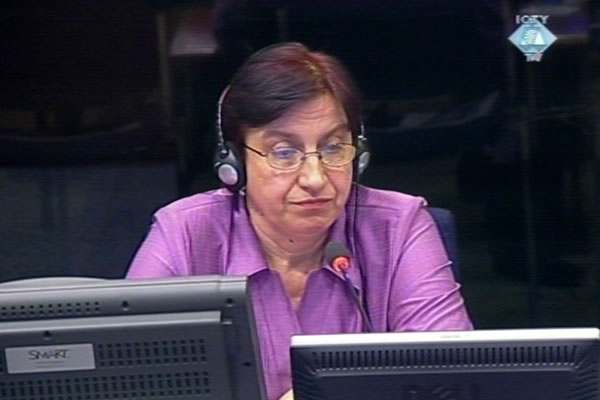Home
YEARS OF HUNGER AND DEATH IN SREBRENICA
Mirsada Malagic testified today at the trial of Radovan Karadzic. After the fall of the Srebrenica enclave, Malagic’s husband, two sons and several other relatives were killed. Karadzic tried to blame the killings in Srebrenica on the individuals who had quarreled with their Muslim acquaintances and now wanted to ‘get even’ with them
 Mirsada Malagic, witness at the Radovan Karadzic trial
Mirsada Malagic, witness at the Radovan Karadzic trial Under the pressure of the local Serb authorities, Mirsada Malagic, her husband and three children left their family house in the village of Voljavica near Bratunac. They sought shelter in Srebrenica, which had already been burned down and looted by the Serb paramilitaries by that time.
As the witness said, what food there was in Srebrenica was soon consumed and her family and other refugees from Podrinje ‘had to go hungry’. They were forced to literally ‘beg’ for food. They gave most of the food they got to the children. The witness said she was so exhausted by January 1993 that she could no longer walk. ‘You are hungry, you should eat’, a local doctor told the witness.
She and other refugees were saved that winter by the packages air dropped by the UN to the Srebrenica region. Humanitarian convoys started coming in later. At the beginning, enough food came in, but as time went by, humanitarian relief supplies again dwindled. In June 1995, according to the estimates, about 40,000 hungry and exhausted persons lived in an area the size of five square kilometers in Srebrenica.
On 11 July 1995 the witness, her youngest son and her father-in-law headed towards the UN base in Potocari. Her two other sons, husband and his two brothers joined the column that was heading towards Tuzla through the woods. On their way from Srebrenica to the UNPROFOR base, the refugees were shelled and Mirsada was injured, but was able to get to Potocari. The witness, her father-in-law and her son sought shelter inside the nearby galvanization plant and spent the night there.
On 12 July 1995 in the afternoon, the witness saw Serb soldiers taking groups of men to a house behind the galvanization plant. None of those men returned. A day later, in the morning of 13 July 1995, the soldiers took the witness’s father-in-law out and to the ‘white house’. The witness saw that he was forced to throw down the things he had with him in the yard. At the same time, the witness and her 11-year-old son were put on a bus and driven away towards Tuzla.
The remains of the witness’s husband and one of her sons were identified in 2009 and buried in Potocari, in the same place as her father-in-law who was buried there two years earlier. Seven days before she was called to give evidence at the Karadzic trial the witness was informed that the body of her other son had been recovered. The witness will go though the identification procedure and other formalities when she returns home.
At the end of her examination-in-chief, Mirsada Malagic said she didn’t visit her family house in Bratunac often because it’s psychologically very difficult. As she said, the solitude and memories of the life she had had there before 1992 with her family who are not longer there, were killing her.
In the cross-examination, Karadzic as usual claimed he felt ‘solidarity’ with the victim, and then proceeded with his effort to ‘complete the picture’ of what happened in Srebrenica from the beginning of the conflict to the fall of the enclave in July 1995. Karadzic tried to blame the killings in Srebrenica on the individuals who took the opportunity to ‘get even’ for any quarrels they may have had with their Muslim acquaintances.
The witness noted that she and other refugees in Srebrenica didn’t think there was any reason for revenge. The witness also dismissed the suggestion that there was a ‘Muslim army’ that was in any respect comparable to the VRS. The men in Srebrenica were ‘able-bodied’ but were not ‘proper soldiers’ because they barely had any weapons and equipment.
This time, Karadzic didn’t insist on his argument that there was enough food in Srebrenica in the winter of 1993. Karadzic made no mention of hens, goats and other domestic animals and food which was there in sufficient quantities, as he had done before.
After Mirsada Malagic completed her evidence, the prosecution called Tomasz Blaszczyk who is an OTP investigator. For the Popovic trial, Blaszczyk put together a book with the sketches and photos of the locations in the Srebrenica area; the book is based on the video recorded by Zoran Petrovic Pirocanac on 13 and 14 July 1995.
Linked Reports
- Case : Karadzic
- 2012-01-20 KARADZIC’S MOTION TO RECALL 12 ‘MUNICIPALITY WITNESSES’ REJECTED
- 2012-01-18 WHO’S RESPONSIBLE FOR THE BAD IMAGE OF KARADZIC’S TROOPS IN WESTERN MEDIA?
- 2012-01-17 KARADZIC: ‘SERBS PROVED THEIR NOBILITY’ IN SREBRENICA
- 2012-01-25 ON TRAIL OF PIROCANAC’S SREBRENICA VIDEOS
- 2012-01-26 KARADZIC FALLS BACK ON SUNSHINE AND SHADOWS IN HIS DEFENSE
- 2012-01-27 KARADZIC WANTS INTERVIEWS WITH GREEK PRESIDENT AND FRENCH OFFICER
